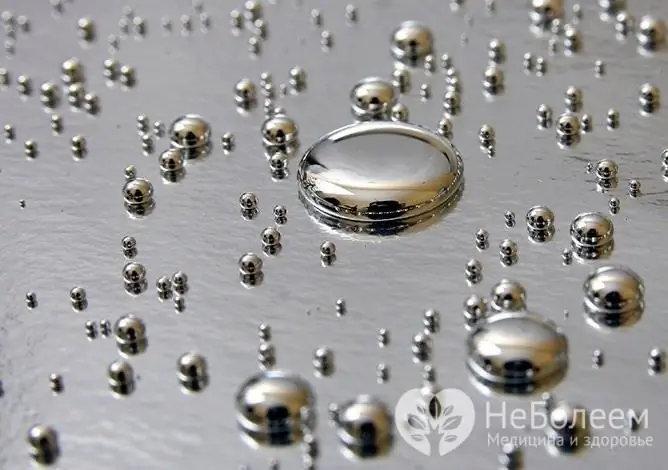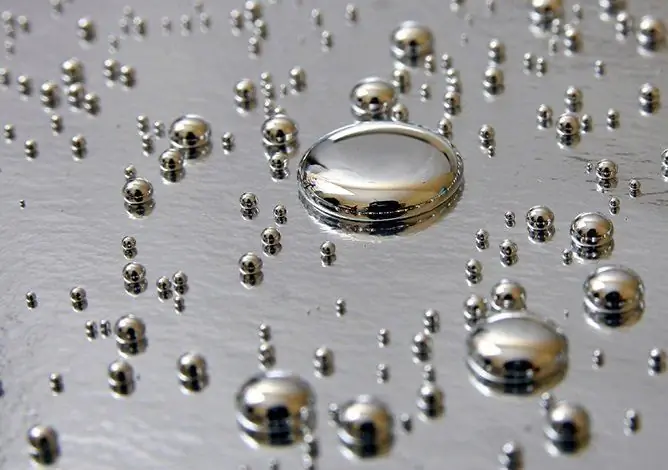How to collect mercury from a broken thermometer
The content of the article:
- How to properly collect mercury if a thermometer crashed in an apartment
- Do's and don'ts when collecting mercury
- Signs of mercury poisoning
- First aid for mercury poisoning
Collecting mercury from a broken thermometer is not an easy task, read our article on how to do it correctly.
The mercury medical thermometer is widely used due to the accuracy of body temperature measurement, affordable price and ease of use. However, in addition to the obvious advantages, this type of thermometer also has a significant disadvantage, namely the use of mercury as the working medium of the measuring device.

Mercury belongs to toxic substances of I hazard class
Mercury is a transition metal that belongs to the zinc subgroup, is in a liquid state at room temperature and has the properties of a diamagnetic. Mercury vapor is colorless and odorless, extremely toxic to humans and can accumulate in the body, causing toxic effects on the digestive, nervous, immune system, skin, kidneys and eyes. Mercury is especially dangerous for women during pregnancy and for the developing fetus.
How to properly collect mercury if a thermometer crashed in an apartment
If a mercury thermometer breaks in the house, first of all, it is necessary to remove all people and pets from the room, then close the door to the room in which the mercury has spread and open the window. In this case, it is necessary to prevent a draft, as it promotes the spread of a toxic substance. You can collect mercury from a broken thermometer on your own, however, if metal balls get into hard-to-reach places, or in doubtful cases, it is advisable to call a service that specializes in demercurization.
Before you start collecting mercury on your own, you need to put on a respirator or cotton-gauze bandage soaked in an aqueous solution of baking soda (30 g per 200 ml of water), rubber gloves, and rubber shoes or medical shoe covers over ordinary shoes.

Protect your skin before collecting mercury
First you need to collect the remnants of the broken thermometer. The collected mercury is placed in a tightly closed jar with water or potassium permanganate solution, as this prevents its further evaporation. You can collect mercury from the floor using a double-folded sheet of paper (or two sheets), a rubber syringe, a disposable syringe, wet cotton wool, a brush, and a copper plate. You can also use napkins soaked in vegetable oil or newspapers soaked in water. It is convenient to collect small balls of mercury with a piece of scotch tape or adhesive plaster.
A syringe or a disposable syringe will help to collect mercury from the carpet, after which the carpet must be taken out of the house and left for several days outside or on an open balcony for ventilation. All small items that were used to collect mercury are placed in the same jar with water or potassium permanganate solution.
After collecting the mercury, all surfaces with which it has come into contact must be treated in order to remove the toxic substance as much as possible. For this, a 20% aqueous solution of ferric chloride can be used, however, it must be borne in mind that this substance is also toxic and leaves stains on some surfaces. After treatment with ferric chloride, the surface should be thoroughly washed with soap and soda solution. Instead of ferric chloride, a solution of potassium permanganate or any chlorine-containing substance can be used. During the next week, the room in which the thermometer crashed is thoroughly ventilated and regularly cleaned. In this case, you should not cool the room too much, since the remaining mercury will evaporate more slowly and remain in the house longer. It is also not recommended to sleep or stay for a long time in a room where mercury was spilled from a broken thermometer for a week.
The collected mercury should be taken to a mercury collection and disposal site. Clothes and large items that have come into contact with a toxic substance should be placed in a sealed bag or sealed container and also given for recycling.
If it is necessary to measure the concentration of mercury vapor in the air of the room in which the thermometer was broken, you should use the services of an accredited laboratory.
Do's and don'ts when collecting mercury
When trying to collect mercury, do not use a vacuum cleaner, as the heat from the engine of a running device will cause the toxic substance to evaporate more quickly, which can lead to adverse health effects. In addition, if you collect mercury with a vacuum cleaner, its particles will settle on its inner surface, after which toxic fumes will continue to spread in the room.
Also, do not try to collect the mercury with a broom - this will crush it and complicate cleaning. Do not collect mercury with a rag or squeeze mop, as this will spread the substance around the room and will only aggravate the situation. Since this metal is a diamagnetic, it is not advisable to try to collect mercury with a magnet.

Do not vacuum up spilled mercury
It is dangerous to touch the substance with bare hands, stay in the room for too long where the thermometer has broken and mercury has leaked out (when cleaning, you should take regular pauses, leave the room and breathe fresh air), leave children and pets indoors.
The collected mercury must not be thrown into the garbage chute or drained into the sewer, as this poses a danger to the environment and other people (mercury can get into the ground, water bodies, settle on sewer pipes).
Clothes that have been used to collect mercury and clean the premises must not be machine washed. Items that have come into contact with a poisonous substance are not subject to further use. The collected mercury must not be stored in the immediate vicinity of heating devices and / or in a poorly sealed container until disposal.
It should be remembered that in order to avoid damage to the medical mercury thermometer, do not leave it in a place accessible to children, fall asleep with it while measuring body temperature, take the device with wet hands and allow small children to use the thermometer on their own.
Signs of mercury poisoning
Since mercury begins to actively evaporate already at a temperature of 18 ° C, the most likely way of getting into the body is inhalation of its vapors. After entering the respiratory tract, mercury is absorbed mainly in the lungs, from where a significant part (80-100%) enters the bloodstream.
The absorption of elemental mercury, which is used in medical thermometers, is negligible in the gastrointestinal tract. The half-life of elemental mercury from the human body is approximately 60 days.
Mercury poisoning can be acute or chronic. When the body is exposed to high concentrations of the substance, the first signs of poisoning develop within a few hours after contact. In acute poisoning, nausea (sometimes vomiting), pain in the abdomen and / or chest, impaired appetite, diarrhea, metallic taste in the mouth, fever, shortness of breath, emotional instability are observed. Acute mercury vapor poisoning causes an inflammatory process in the respiratory tract with the development of interstitial pneumonitis, which, in turn, can lead to respiratory failure.

If a thermometer breaks in an apartment, mercury can penetrate into the cracks in the floor, under the baseboards, spread around the apartment on the soles of shoes and have a long-term adverse effect on the human body, therefore, mercury should be collected as soon as possible. Mercury belongs to the cumulative poisons, that is, it has the property of accumulating in the body, causing chronic poisoning. It manifests itself as persistent headache, stomatitis, anemia, stool disorders, and in some cases, disorders of the urinary system. In chronic mercury poisoning, rapid fatigue appears, body weight decreases, salivation increases, teeth collapse, and rashes form on the skin. Photophobia, profuse sweating, accompanied by desquamation of the skin of the feet and palms, hypotension,heart rhythm disturbances. With further exposure to mercury on the body, tremor of the hands and eyelids develops, which eventually becomes generalized and is accompanied by sleep disturbances, anxiety (mercury erethism).
In the course of a clinical blood test, a decrease in the level of hemoglobin, a decrease in the number of erythrocytes and leukocytes, and a shift in the leukocyte formula to the left are determined.
Mercury can easily penetrate the placental barrier, as well as through the blood-brain barrier, with further damage to the central nervous system of the fetus. Exposure to mercury on the body of a pregnant woman can lead to atrophy of the cerebral cortex and cerebellum of the fetus, the onset of cerebral palsy.
First aid for mercury poisoning
If you find the first signs of acute mercury poisoning, you should urgently seek medical help. Before the arrival of the doctor, the victim should be taken out into the fresh air and given plenty of water, and you should also try to collect the mercury in the room as soon as possible, observing all precautions. If mercury is swallowed, try to induce vomiting and take enterosorbent.
In case of chronic poisoning, stop contact with mercury and consult a doctor.
YouTube video related to the article:

Anna Aksenova Medical journalist About the author
Education: 2004-2007 "First Kiev Medical College" specialty "Laboratory Diagnostics".
Found a mistake in the text? Select it and press Ctrl + Enter.







